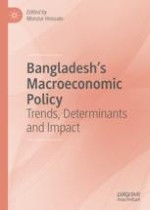2020 | OriginalPaper | Buchkapitel
6. A Review of Public Expenditures in Bangladesh: Evidence on Sustainability and Cyclicality
verfasst von : Zahid Hussain, Monzur Hossain
Erschienen in: Bangladesh's Macroeconomic Policy
Verlag: Springer Singapore
Aktivieren Sie unsere intelligente Suche, um passende Fachinhalte oder Patente zu finden.
Wählen Sie Textabschnitte aus um mit Künstlicher Intelligenz passenden Patente zu finden. powered by
Markieren Sie Textabschnitte, um KI-gestützt weitere passende Inhalte zu finden. powered by
